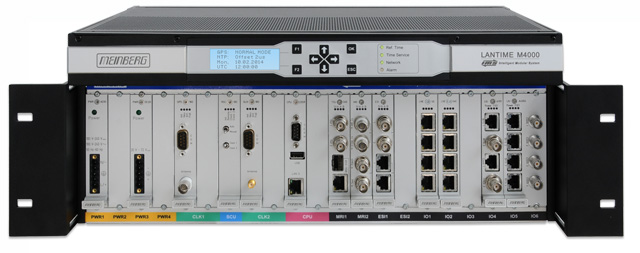EANTC Interoperability Test Event 2015 in Berlin, Germany

The European Advanced Networking Test Center (EANTC) is an international leading and objective test center. It provides vendor-neutral network test facilities for manufacturers, service providers and enterprise customers. Every year the EANTC organizes an Interoperability Test Event where different manufacturers can participate.
This year Meinberg has decided to join the EANTC Interoperability Testing, because more and more telecom optimized systems are being added to Meinberg’s product range. This is a very good way to guarantee interoperability of new Meinberg products. The main focus of this year’s event is the LTE clock synchronization readiness for phase and time.
For example modules with new features and properties for telecom applications have been added to Meinberg’s Intelligent Modular System (IMS) series, such as the Phase/Time Telecom Profile ITU-T G.8275.1, Assisted Partial Timing Support (APTS) for Edge Grandmaster functionality and Synchronous Ethernet support.
Meinberg will test two for telecom applications relevant Meinberg products during the EANTC Interoperability Test Event 2015.
EANTC Service Provider Day
Meinberg would like to invite you to the “Service Provider Day” on February 2nd, 2015, an event organized within the EANTC Interoperability Testing.
For more information and registration to the Service Provide Day please use the following link:
MEINBERG Telecom-Solutions
IMS-M4000
M4000 chassis - based on a 4U enclosure
Due to the fact that all connectors and control elements of the M4000 are placed on one side and its chassis
can either be built into a 300mm ETSI rack or into a 19inch rack, the M4000 is the ideal synchronization solution
for telecommunication networks.
The form factor and the mounting brackets are compatible to ETSI rack (standard ETS 300 119-2). The upper 1U section of the case provides free space for optional fan boards.
The M4000 can act as a Telecom Grandmaster for hundreds of clients. For NTP-based synchronization, each of the TSU module network interfaces of the LANTIME M4000 can be configured to act as a carrier grade NTP server with 10 ns time stamp accuracy, serving up to 12000 NTP requests per second on each port.
IMS-M1000
The M1000 basic configuration supports additionally up to 16 pulse and frequency outputs like PPS, 10 MHz as well as software selectable T1 or E1 outputs to synchronize Telecom equipment or measurement devices.
IMS Lantime Systems
Key Features:
- GNSS (GPS and/or GLONASS) synchronized PRTC (compliant to ITU-T G.8272)
- IEEE 1588 Grandmaster (multi-profile, incl. ITU-T G.8275.1 and G.8265.1)
- Synchronous Ethernet In/Out
- GBit PTP Interfaces (SFP/RJ45)
- Carrier Grade NTP Time server with HW time stamping
- E1/T1 BITS and Clock In/Out (ITU-T G.703)
- 1PPS In/Out, 10 MHz In/Out
- PTP and NTP Input
- IEEE 802.1Q VLAN Tagging
- DSCP and IEEE 802.3p QoS
- Web GUI, CLI, SNMP, RADIUS, TACACS+
- Redundant DC and AC power supplies
The modularity of the IMS platform (Intelligent Modular System) allows the configuration for all areas of a mobile backhaul network: in the core, metro or access levels.
Depending on the installed modules and the selected synchronization sources, the 1U rackmount LANTIME M1000 can play different roles. By supporting multiple input sources utilizing Meinberg‘s IRSA (Intelligent Reference Switching Algorithm) technology, the M1000 accepts GPS, GLONASS, PTP, NTP, SyncE, 1PPS or E1/T1 as possible synchronization inputs to be able to act as an Edge Grandmaster Clock. IRSA is useful to bridge potential GNSS outages or, if desired, completely avoid depending on GPS/GLONASS availability. A highly stable oscillator ensures a holdover period of several hours or days depending on the target application even if no synchronzation source is available anymore. Using an external PRC allows to extend the holdover capabilities to whatever level is required at a certain point in the network.
The PTP implementation supports both ITU-T profiles, ITU-T G.8265.1 for frequency and ITU-T G.8275.1 for frequency and phase. This allows to provide accurate frequency and phase synchronization over packet networks to all network elements requiring synchronization, including 2G/3G/4G base stations as well as LTE advanced networks.
The modular approach of the IMS platform allows field-replacement and hot-swap capabilities for IO modules and power supplies. This concept ensures future-proofness and expandibility by allowing to add or replace modules when new technologies or interfaces are required and makes this product one of the most scalable and flexible synchronization solutions on the market.





